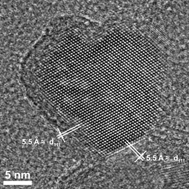Structural investigations and acidic properties of high surface area pyrochlore aluminium hydroxyfluoride†
Abstract
High surface area

* Corresponding authors
a
Institut de Chimie de la Matière Condensée de Bordeaux - CNRS, Université Bordeaux 1. 87, Avenue du Dr. A. Schweitzer, 33608 Pessac cedex, France
E-mail:
demourg@icmcb-bordeaux.cnrs.fr
Fax: +33 (0)5 4000 2650
Tel: +33 (0)5 4000 2655
b Laboratoire des Oxydes et Fluorures, CNRS UMR 6010, IRIM2F, CNRS FR 2575, Université du Maine, Avenue Olivier Messiaen, 72085 Le Mans Cedex 9, France
c Laboratoire Catalyse et Spectrochimie, ENSICAEN, Université de Caen, CNRS, 6 Bd Maréchal Juin, F-14050 Caen Cedex, France
d Laboratoire de Physique de l'Etat Condensé, CNRS UMR 6087, IRIM2F, CNRS FR 2575, Université du Maine, Avenue Olivier Messiaen, 72085 Le Mans Cedex 9, France
e Centre de Recherche sur les Matériaux à Haute Température, CNRS UPR 4212, 1D Avenue Recherche Scientifique, 45071 Orléans Cedex 2, France
High surface area

 Please wait while we load your content...
Something went wrong. Try again?
Please wait while we load your content...
Something went wrong. Try again?
D. Dambournet, A. Demourgues, C. Martineau, E. Durand, J. Majimel, A. Vimont, H. Leclerc, J.-C. Lavalley, M. Daturi, C. Legein, J.-Y. Buzaré, F. Fayon and A. Tressaud, J. Mater. Chem., 2008, 18, 2483 DOI: 10.1039/B718856K
To request permission to reproduce material from this article, please go to the Copyright Clearance Center request page.
If you are an author contributing to an RSC publication, you do not need to request permission provided correct acknowledgement is given.
If you are the author of this article, you do not need to request permission to reproduce figures and diagrams provided correct acknowledgement is given. If you want to reproduce the whole article in a third-party publication (excluding your thesis/dissertation for which permission is not required) please go to the Copyright Clearance Center request page.
Read more about how to correctly acknowledge RSC content.
 Fetching data from CrossRef.
Fetching data from CrossRef.
This may take some time to load.
Loading related content
